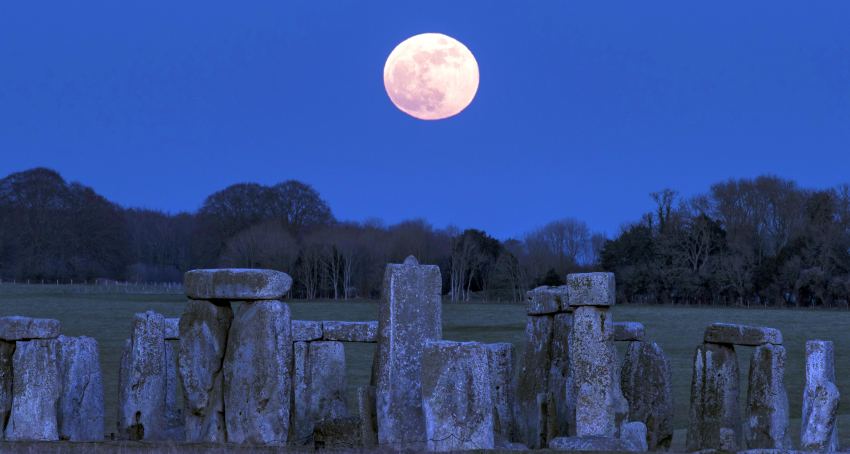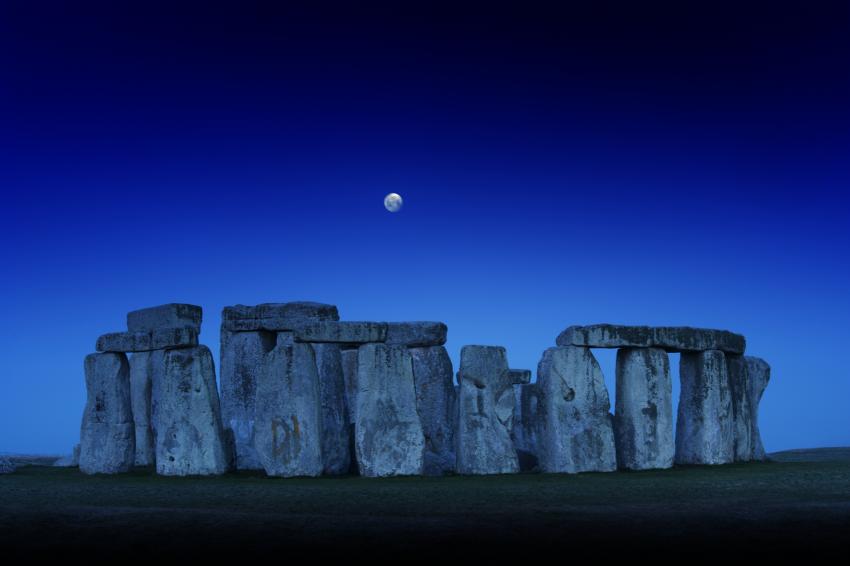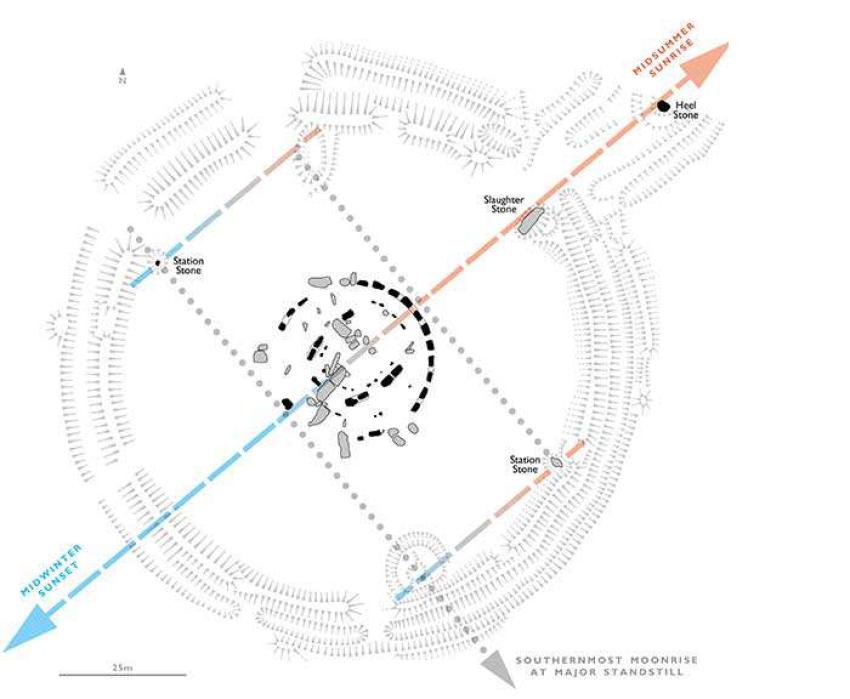The possibility that Stonehenge aligns with the positions of the Moon - as well as the Sun - is being investigated by a team of experts and organisations including the Royal Astronomical Society.
Archaeoastronomers led by English Heritage will study the connection between the ancient monument and a ‘major lunar standstill’ — a rare astronomical phenomenon which happens every 18.6 years.
It refers to the point when Moonrise and Moonset reach their furthest points along the horizon and is next taking place from this year into next.
Academics from Oxford, Leicester and Bournemouth universities believe these once-in-a-generation lunar movements may have been noticed in the early phase of Stonehenge, and therefore influenced its later design.
Their research into the theory will begin this spring and last until the middle of 2025.
Professor Clive Ruggles, emeritus professor of archaeoastronomy at Leicester University, said: “Stonehenge’s architectural connection to the Sun is well known, but its link with the Moon is less well understood.
“The four Station Stones align with the Moon's extreme positions, and researchers have debated for years whether this was deliberate, and - if so - how this was achieved and what might have been its purpose.”
Jennifer Wexler, English Heritage’s historian for Stonehenge, said: "We're excited to be working with a brilliant team of archaeoastronomers to explore the fascinating link between Stonehenge and the major lunar standstill.
“Rarer even than once-in-a-blue-moon, this opportunity allows us to delve deeper into the monument's ancient mysteries and its relationship with celestial phenomena.
“We’ll be inviting the public to join us through a series of events this year as we take one more small step towards unravelling the secrets of Stonehenge.”
To bring this research to life, English Heritage will livestream the southernmost Moonrise at Stonehenge. The charity will also host a series of events throughout the standstill season including talks, a pop-up planetarium, stargazing and storytelling sessions, and a new display in the exhibition space.
Dr Robert Massey, of the Royal Astronomical Society, said: “Night and day, the Moon is a universally loved feature of the sky, and something all of us are drawn to look at.
“The major standstill offers even more dramatic views of our celestial neighbour when it rises and sets, and will be an astronomy highlight of 2024.
“The RAS is delighted to be supporting events at Stonehenge to mark and investigate this rare event.”
Dr Amanda Chadburn, of the University of Oxford’s Kellogg College, said: “Observing this connection first hand in 2024 and 2025 is crucial.
“Unlike the Sun, tracking the Moon's extremes isn't straightforward, requiring specific timing and weather conditions.
“We want to understand something of what it was like to experience these extreme Moonrises and sets and to witness their visual effects on the stones (for example, patterns of light and shadow), and consider modern influences like traffic and trees, and to document all of this through photography for future study.”
Dr Fabio Silva, a senior lecturer in archaeological modelling at Bournemouth University and co-founder and managing editor of the Journal of Skyscape Archaeology, said: “Bournemouth University lecturers and students will document Moonrises and sets at key moments in the year when the Moon will be in alignment with the Station Stones.
“This will happen at different times of day and night around the year, with the Moon being at the right place on different phases each month. Hence, some will be more dramatic (such as a full Moon or crescent Moon) than others.
“The team will capture these phenomena, aiming to explore the complex relationship between the landscape, stones, and the Moon over the course of the standstill ‘season’”.
To find out more about Stonehenge, its possible connection to the Moon and the ways in which you can get involved, visit: www.english-heritage.org.uk/visit/places/stonehenge/things-to-do/major-lunar-standstill/
Media contacts
Sam Tonkin
Royal Astronomical Society
Mob: +44 (0)7802 877700
Robert Massey
Royal Astronomical Society
Mob: +44 (0)7802 877699
Jessica Trethowan, PR Manager
English Heritage
Mob: +44 (0)7880 052025
jessica.trethowan@english-heritage.org.uk
Press Office
Tel: +44 (0)207 973 3390
Images and captions
Caption: A team of experts are investigating the possibility that Stonehenge aligns with the positions of the Moon, as well as the Sun.
Copyright: Andre Pattenden/English Heritage
Caption: English Heritage, along with several archaeoastronomers and the Royal Astronomical Society, will study the connection between the ancient monument and a ‘major lunar standstill’ — a rare astronomical phenomenon which happens every 18.6 years.
Copyright: James O Davies/English Heritage
Caption: Academics believe such once-in-a-generation lunar movements may have been noticed in the early phase of Stonehenge, and therefore influenced the monument’s later design (pictured).
Copyright: English Heritage
Notes for editors
Stonehenge and the Moon
Several centuries before the large stones were brought to Stonehenge, people were burying cremated remains in the ditch and bank that now surrounds the stone circle, and in the Aubrey Holes – 56 pits which may originally have housed upright timber posts or stones.
Notably, many of these cremations were concentrated in the south-east of the monument, aligning with the most southerly rising position of the Moon, where three timber posts were set into the bank. The long axis of the rectangle formed by the four Station Stones also shares this orientation, suggesting a compelling and enduring connection between the lunar cycles and the burial practices of the people of Stonehenge.
Academic partners
Amanda Chadburn is a visiting fellow at the Department of Archaeology and Anthropology, Bournemouth University, a member of Kellogg College, University of Oxford, and was formerly English Heritage’s lead adviser for the Stonehenge and Avebury World Heritage Site. She worked for more than 35 years for English Heritage/Historic England, is currently a trustee of the charity World Heritage UK, and a session tutor at the University of Oxford. She has been working closely with Professor Ruggles on archaeoastronomy and world heritage since 2009, and their jointly-authored book about the Sun and Moon at Stonehenge - Stonehenge: Sighting the Sun - will be published in May.
Clive Ruggles is emeritus professor of archeoastronomy in the School of Archaeology and Ancient History at Leicester University. He has spent a lifetime investigating ancient people’s perceptions of the sky and in 2017 was awarded the Royal Astronomical Society’s Agnes Mary Clerke Medal for a “lifetime of distinguished work in the overlapping areas of archaeology, astronomy and the history of science”. He worked for many years with UNESCO leading an Initiative to promote astronomical World Heritage Sites and was co-discoverer of the monumental solar observatory at Chankillo in Peru, which itself became a UNESCO World Heritage Site in 2021. He continues to serve on the International Astronomical Union’s Working Group on Star Names and the Dark Skies Advisory Group of the International Union for the Conservation of Nature.
Fabio Silva is senior lecturer in archaeological modelling at the Department of Archaeology and Anthropology of Bournemouth University, and co-founder and managing editor of the Journal of Skyscape Archaeology – the leading academic publication on the topic of archaeoastronomy. With a background in theoretical astrophysics, Dr Silva retrained in archaeology and has spent the last 14 years working in the latter field. His research focuses on how societies perceive and conceive their worlds and use that to time and adjust social, productive and magico-religious behaviours, especially in prehistory. He is also interested in the development and application of robust and reflexive approaches to archaeoastronomy. This has led him to primarily study prehistoric structures in the United Kingdom and the Iberian Peninsula. In 2016, the European Society for Astronomy in Culture awarded him the Carlos Jaschek Award for “outstanding contributions in the fields of cultural astronomy and archaeoastronomy” - the youngest scholar ever to receive it.
About English Heritage
English Heritage cares for over 400 historic buildings, monuments and sites - from world - famous prehistoric sites to grand medieval castles, from Roman forts on the edge of the empire to a Cold War bunker. Through these, the charity brings the story of England to life for over 10 million people each year. To find out more about English Heritage and its role, visit www.english-heritage.org.uk
About the Royal Astronomical Society
The Royal Astronomical Society (RAS), founded in 1820, encourages and promotes the study of astronomy, solar-system science, geophysics and closely related branches of science. The RAS organises scientific meetings, publishes international research and review journals, recognises outstanding achievements by the award of medals and prizes, maintains an extensive library, supports education through grants and outreach activities and represents UK astronomy nationally and internationally. Its more than 4,000 members (Fellows), a third based overseas, include scientific researchers in universities, observatories and laboratories as well as historians of astronomy and others.
The RAS accepts papers for its journals based on the principle of peer review, in which fellow experts on the editorial boards accept the paper as worth considering. The Society issues press releases based on a similar principle, but the organisations and scientists concerned have overall responsibility for their content.




